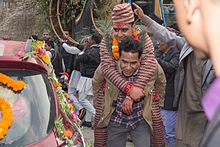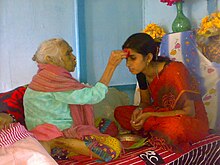Culture of Nepal
This article needs additional citations for verification. (December 2007) |
| Part of a series on the |
| Culture of Nepal |
|---|
 |
| Society |
| Topics |
|
| Symbols |
|
The culture of Nepal encompasses the various cultures belonging to the 125 distinct
Dance and music


Languages
As many as 123 languages are spoken in Nepal according to
Nepali, written in Devanagari script, is the official national language and serves as lingua franca among Nepalese ethnolinguistic groups.
Religions and philosophy

The 2011 census identified 81.6% of the population being
Hindu and Buddhist traditions in Nepal go back more than two
Festivals and celebrations


Several of the
Other important festivals include
region, celebrate Mani Rimdu, for the good of the world.Most festivals include dancing and music, and a variety of special foods are consumed during festivals and on special occasions.
The Sagan ceremony is the ritualized presentation of five food items (boiled egg, smoked fish, meat, lentil cake and rice wine) to a person which is done to bring good fortune as per Tantric tradition.
Architecture and archaeology

Nepal Sampada Sangha (Nepal Heritage Society) has compiled an inventory of 1,262 significant architectural and archeological sites in Nepal outside Kathmandu Valley.[9]
Sports
The government declared volleyball as the national game of the country. Before it used to be dandi biyo.
A Cabinet meeting held at the Prime Minister Pushpa Kamal Dahal's residence in Baluwatar took the decision. The Ministry of Youth and Sports had put the proposal to declare volleyball as the national game. Nepal Volleyball Association had been demanding that the sport, which is played in all 75 districts of the country, should be the national game.
National Sports Council's former Member Secretary Yubaraj Lama had initiated the process of deciding the national game, while the current Member Secretary Keshab Kumar Bista had recommended for the national game.[10]
Gallery
-
Procession of Nepali Pahadi Hindu Wedding
-
Nepali Pahadi groom
-
Procession of Nepali Hindu Wedding
-
Nepali Pahadi Hindu marriage at Narayangadh, Chitawan
See also
- Boudhanath
- Chitrakar
- Cinema of Nepal
- Dhunge Dhara
- Languages of Nepal
- Media of Nepal
- Menstruation hut
- Music of Nepal
- Naga Panchami
- National Museum of Nepal
- Nepal Bhasa literature
- Nepalese architecture
- Nepalese cuisine
- Nepali literature
- Newa art
- Religion in Nepal
- Thangka
- Traditional Newar clothing
References
- ^ "2011 Nepal Census Report" (PDF). Archived from the original (PDF) on 18 April 2013.
- from the original on 2021-11-10. Retrieved 2019-09-10.
- ^ Gubhani, Juhee. "Re-Visiting the Question: Are Rājopādhyāyas Newārs of Nepal?".
- ^ McDonnaugh, Christian. "The mythology of the Tharu: aspects of cultural identity in Dang, West Nepal" (PDF). Archived (PDF) from the original on 2020-07-29. Retrieved 2019-09-10.
- ^ "Major highlights" (PDF). Central Bureau of Statistics. 2013. p. 4. Archived from the original (PDF) on 17 July 2013. Retrieved 1 November 2013.
- ^ yukesh0007 (2019-05-22). "Festival around Nepali New Year". Soul of Himalayas. Archived from the original on 2020-01-29. Retrieved 2020-01-29.
- ^ "Buddha Jayanti". We All Nepali. Archived from the original on 2015-05-05. Retrieved 2015-06-01.
- ^ "Maha Shivaratri". We All Nepali. Archived from the original on 2015-05-20. Retrieved 2015-06-01.
- ^ Bhandari, Bishnu, ed. (1997). Inventory of heritage sites in Nepal. Kathmandu: IUCN Nepal. Archived from the original on July 21, 2011. Retrieved April 15, 2011.
- ^ "Volleyball declared national game | the Himalayan Times". 24 May 2017. Archived from the original on 2019-05-07. Retrieved 2019-05-07.
Further reading
- Kramrisch, Stella. "The Art of Nepal and Tibet." Philadelphia Museum of Art Bulletin 55.265 (1960): 23–38.
- Hutt, Michael. Nepal: A guide to the art and architecture of the Kathmandu Valley. Kiscadale Publications, 1994.
- Pal, Pratapaditya. Art of Nepal: a catalogue of the Los Angeles County Museum of Art collection. Univ of California Press, 1985.
- von Schroeder, Ulrich. Nepalese Stone Sculptures. Volume One: Hindu; Volume Two: Buddhist. (Visual Dharma Publications, 2019). ISBN 9783033063815
- Folktale collections
- Hitchcock, Patricia; Sader, Lillian (1966). The king who rides a tiger, and other folk tales from Nepal. Berkeley, California: Parnassus Press.
- Some Folk Tales of Nepal. Department of Culture, Ministry of Information and Broadcasting, HMG for Nepal National Commission for UNESCO, Ministry of Education, HMG. 1968.
- Aganina, Lyudmila A. [in Russian]; Шресткха, K. (1971). Живой в царстве мертвых. Сказки народов Непала" [Alive in the Realm of the Dead: Tales from Peoples of Nepal] (in Russian). Мoskva: Художественная литература.
- Sakya, Karna; Griffith, Linda (1980). Tales of Kathmandu: Folktales from the Himalayan kingdom of Nepal. House of Kathmandu. ISBN 9780959443905.
- Heunemann, Annette, ed. (1980). Der Schlangenkönig. Märchen aus Nepal. Das Gesicht der Völker (in German). Vol. 47. Kassel: Röth.
- Kretschmar, Monica (1985). Märchen und Schwänke aus Mustang (Nepal) (in German). Sankt Augustin: VGH Wissenschaft Verlag.
- Unbescheid, Günter (1989). Märchen aus Nepal (in German). Jena: Eugen Didierichs Verlag.
- Shrestha, Kavita Ram (1997). From the mango tree and other folktales from Nepal. Libraries Unlimited.
External links
- culture in nepal
- Nepal Encyclopedia culture category Archived 2012-07-25 at the Wayback Machine
- Culture, religions and festivals of Nepal (archived 2 August 2013)
- Languages of Nepal
- Literature of Nepal
- Photographs of Heritage Sites of Nepal Archived 2020-07-29 at the Wayback Machine




